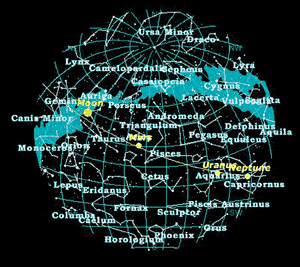 The December sky is dominated by Orion (Mrigashira). It is one of the largest constellations in the sky and also one of the easiest to find because of the distinctive three stars (Tin-tare) that make up the Hunter's 'belt'. Embedded in the 'dagger' is the Orion Nebula (M42), birthplace of young stars.
The December sky is dominated by Orion (Mrigashira). It is one of the largest constellations in the sky and also one of the easiest to find because of the distinctive three stars (Tin-tare) that make up the Hunter's 'belt'. Embedded in the 'dagger' is the Orion Nebula (M42), birthplace of young stars. Like any successful hunter, Orion is accompanied in the sky by faithful 'dogs': Canis Major and Canis Minor. Canis Major is the home of Sirius, the brightest star in the sky. Other celestial highlights in December:
The Sun
The sun is 'travelling' eastwards through the constellation of Ophiuchus and crosses the border into Sagittarius on the 18th.
The Earth
The earliest sunset of the year is on the 12th and the latest sunrise is on the 31st. Between them lies the Winter Solstice, which this year occurs on 22 December at 0020, making it the shortest day of the year in the northern hemisphere.
The Moon
There are two new moons this month, on 1 and 31 December. On 5 December, the moon is at perigee, the closest point to earth in its monthly orbit, at a distance of 367,365 km. On the day of the winter solstice, the moon reaches apogee, at its greatest distance from the earth (405,014 km).
Mercury
Mercury appears before dawn during the first half of the month. This quick moving planet reaches its greatest elongation west of the sun on the 12th, at an angular distance of 21?. At this time, it rises a full two hours before the sun. Jupiter will be ahead of Mercury at a distance of 20?.
Venus
Venus will grab our attention after sunset as the 'Evening Star' just above the western horizon. It will pair dramatically with the moon on 4 December and reach greatest brilliancy on 9 December when it will outshine everything in the sky. This is a good time to observe the crescent phase of the planet, which can be seen even through binoculars.
Mars
Mars is out nearly all night and is magnificent as it hangs slightly below the major stars of Aries. As the month progresses, the planet begins to fade in brightness as Earth leaves it behind in its orbit. On 12 December, the gibbous waxing moon approaches Mars.
Jupiter
Jupiter is a bright 'Morning Star' pulling away rapidly from the sun so that by the end of December, it rises almost five hours before the sun. Just ahead of Mercury all month, it enters Libra, its home, for the next year. It rises at 0412 on 1 December and will be near the Crescent Moon on 26 December. Don't forget to look out for the planet's four major moons, visible even through binoculars.
Saturn
It rises at around 2135 in the beginning of the month and brightens beyond the zero-magnitude threshold in advance of its opposition next month. Saturn will be near the Moon on 19 December. You won't be able to see its rings but can see the glorious beehive star cluster above and to the right of the planet.
Uranus and Neptune
Uranus is amongst the faintest stars in Aquarius and will be 2? north of the Moon on 7 December. Neptune will be among the faint stars of Capricornus in the western quadrant of the sky by nightfall.
Pluto
Time to revise your idea of Pluto. New images from the Hubble Space Telescope have revealed that this distant planet could have two additional moons. Pluto and Earth are aligned on opposite sides of the Sun this month.
Meteor Showers
The heaviest Geminid meteor showers take place overnight from 12 to 15 December. You should be able to see these bright fast moving shooting stars overnight. Unfortunately, the 97 percent illuminated Moon will obscure all but the very brightest of the Geminids. The Ursids peak on 22 December and have a peak hourly rate of about 10. The 55 percent illuminated Moon doesn't rise until after 11 pm so you could be lucky to catch some shooting stars.
[email protected]


